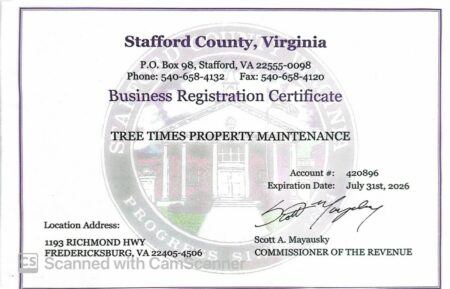Good Evening, I am Billy Kelley, owner of Tree Times Tree Service and Stump Grinding. I would like to thank all you for joining us and taking the extra time to learn more about Soil Preparation and Conversion. We have passed out a guide to follow along with should you like to take notes or have questions throughout this discussion.
What is clay soil:
ay soil is a very dense substance that can cause major drainage problems for your plants. This soil is common to many parts of the world, limiting what homeowners, gardeners, and farmers can grow. However, you can amend or alter the soil to produce a richer soil more suitable for planting. Many plants will struggle to thrive in clay soil, regardless of how effectively you amend it. For example, choosing plants that like very dry or excessively acidic soil can be an uphill battle.
Steps to alter clay soil:
Test soils pH levels – pH is a scale of how acidic or alkaline a material is. The scale goes from 0 to 14, with 0 being very acidic, 7 being neutral, and 14 being very basic.
Test pH of your water – Most water is slightly alkaline, which may or may not be good depending on what you are trying to grow.
- Hard Water – Hard water is generally what groundwater ends up being, mainly because it doesn’t erode the pipes that contain it and transport it around.
- Soft Water – Acidic water is “soft.” Soft water is achieved by removing calcium and magnesium from the water.
- Pure Water – Pure, filtered water is about as neutral as you’ll get. This way, the introduction of water won’t affect the pH of your soil.
Percolation Test – A percolation test will help you determine whether and how well your soil drains. Dig a hole that’s 2 feet (0.61 m) (.6m) deep and 1 foot (0.30 m) (.3m) wide. Fill the hole with water and wait for it to drain completely. Now fill it a second time, keeping track of how long the second water hole drains.
- If it takes less than 12 hours to drain, you can safely plant anything that requires well-drained soil.
- If it takes between 12 and 24 hours for the hole to drain, you can safely grow plants that tolerate heavy soil or clay environments.
- If it takes more than 24 hours for the hole to drain, you can pretty much only plant trees that can hold up to occasional flooding, like balsam fir or red maple.
Till Area w/o Topsoil – Till down to at least 6 inches (15.2cm), and preferably about 8 inches (20.3cm). Extend out a little past the planting area. This will ensure that the roots have extra growing room if they need it.
- If you don’t have a tiller, you can use a broad fork, pitchfork, or shovel to loosen and aerate the soil. The advantage of the broad fork is that you’re not disturbing the essential soil structure, which helps the microorganisms that call the soil their home. The downside to just aerating the soil instead of tilling it is that dense lumps of clay may still exist after soil loosening.
- If you have topsoil with clay underneath, do not till. In this environment, tilling will make the problem worse by mixing clay in with your topsoil.
Amending the Soil – Wait for a dry spell to start amending the clay soil. Clay that is wet is much easier compacted, making the amending a lot more difficult.
Amend a wider section– A small amended area might be a haven for your plants, but when their roots start expanding past the small area and hit the clay, they’ll double back into the amended area quickly. This causes problems with root system development.
Amend Per Soil Test – Most clay soils are on the alkaline side, meaning that you’ll probably want to lower the pH of the soil.
Ex. builder’s sand, gypsum, composted manure, compost or other coarse
organic material.
- Builder’s sand and gypsum allow for better water drainage and increased air pockets, as they force the particles in the clay apart. It is very important to use coarse sand such as builder’s sand, not fine-textured sand such as play sand, as this will make the situation worse.
- Organic matter will help the plants get the proper nutrients and also help build increased humus (not to be confused with “hummus”) with additional microbes that are the building blocks of good soil. Additionally, they will help lower the pH of the soil, acidifying it.
- Try shooting for an equal mix of coarse sand (builder’s sand) and coarse organic material. Because you’re going to be spreading this mix over a large area, you will need bulk quantities: Instead of thinking in terms of square feet, think in terms of cubic yards–one cubic yard of material will provide a three-inch layer on 100 square feet.
- Start off by spreading one cubic yard of organic material on top of every 10-foot by 10-foot area.
- Next, spread one cubic yard of builder’s sand over the same 10′ x 10′ area.
- Continue to monitor the pH of the soil frequently.
Acidify the soil further, if necessary
- By adding an ammonia-based fertilizer
- By adding elemental sulfur or iron sulfate
- By adding cottonseed meal, sphagnum moss, or other compost
Avoid automatic water systems for your plants – Because clay soil is so good at retaining moisture, automatic watering systems may drown your plants if not paid special attention to.
Aeration of Yard – Yard aeration helps to break up the soil to promote unobstructed airflow and water absorption. It will also help to break up the thatch layer that may also be preventing water and nutrients from getting into the soil.
Know what kind of grass you have – Different types of grasses grow most actively during certain seasons of the year.
- Warm-season grasses like buffalo grass, Bermuda grass and St. Augustine grass grow most actively during the summer. If you have warm season grass, it’s best to aerate in the late spring to early summer.
- Cool-season grasses like Kentucky bluegrass, fescue and ryegrass have their most active growing season in the fall, when the temperature drops. Aerate cool season grass at the end of the summer or the beginning of fall.
Know what type of soil you have – Clay-heavy soils need to be aerated frequently, about once a year, since the soil tends to be dense and compact. Sandy soils can be aerated every two years or so.
Know your lawn habits – Do you drive on your lawn often, or frequently have large groups of people walking over it? Lawns that are trampled often need to be aerated once a year to prevent the soil from getting too compact.
- Have you recently reseeded your lawn? It’s best not to aerate within a year of reseeding, since the grass needs time to get strong.
- Test your lawn’s need for aeration by examining how deep the grass’s roots extend into the soil. If the roots don’t go deeper than two inches, you should aerate the soil.
Decide which type of yard aerator to use – There are two types of aerators: power and manual.
- A power yard aerator is a gasoline-driven machine that is best suited for large yards
- A manual yard aerator works more efficiently on small yards or heavily trafficked areas of a lawn
Prep the yard for aeration – Yard aerators work best on cleared, mowed yards. If you have sprinklers, then turn them on for a short time first and mark where each on is so that you can avoid them
Check the moisture level of your yard – If your region has been dry lately, Water your lawn for a few days before you aerate the yard to soften tough soil.
Know which areas of your yard are the most trafficked – Plan to go over those areas with your aerator more than once to ensure you sufficiently aerate that section of yard.
Position the yard aerator in one corner of the yard – Move it from one side of the yard to the other in even rows until the whole area is properly aerated.
- Don’t cover the entire yard more than once. Only double over areas that need extra aeration.
- If your yard requires further aeration, run the yard aerator in the opposite direction from the first pass you took to maximize aeration.
- Leave the cores of earth alone after you aerate. These cores will compost over time and benefit your yard with nutrients. Keep in mind that it might look unsightly for a little while. If someone asks about it, then you can just make a joke and say you have very healthy earthworms.
Fertilize your yard after you aerate it.
Choosing Between Organic and Synthetic Fertilizers
Organic Fertilizer – A mixture that consists largely of decayed organic matter and used for fertilizing and conditioning soil. Testing the soil is a key element in knowing the composition of your existing soil.
Research the nutritional needs of your plants: you will need to know
what chemicals the plants you are growing need in order to thrive.
- For example, if you are growing blueberry bushes, you will want to make the soil acidic.
- If you are growing dahlias, you need to pay attention to the amount of nitrogen, phosphorus, and potassium in your soil.
Pick a type of fertilizer: Different fertilizers will supply different nutrients to your soil. Some common organic fertilizers include - Bird and animal manures: Good source of nitrogen and microorganisms. Needs to be well aged or composted before applying directly to the garden.
- Blood or bone meal: A slow release source of nitrogen. It also has trace minerals. Needs to be applied just before planting and used sparingly.
- Fish meal: Source of nitrogen, phosphorus, potassium, and trace elements. Releases quickly into the soil.
- Greensand: Rich in potassium and micronutrients. Used to break up clay soils.
- Shellfish meal: A good source of calcium, nitrogen, phosphorus, and micronutrients.
- Rock phosphate: Great for flowering plants. Provides long-term phosphate addition.
Locate the product that meets your nutrient needs: The numbers on an organic fertilizer label refer to the percent of three key nutrients in the product: nitrogen (N), phosphate (P), and potassium (K). For example, a fertilizer that is marked 6-12-10 will be 6% nitrogen, 12% phosphate, and 10% potassium. These nutrients are always listed in the same order.
Decide how much fertilizer to use: How much fertilizer you use willdepend on the health of your soil and the amount of space you arefertilizing. The more unbalanced the soil, the more fertilizer your soilwill need and the larger space you are fertilizing, the more fertilizer you will need.
Evaluate the results: Once you have applied the fertilizer according to the package directions, it may take some time to see any results. If the chosen fertilizer isn’t performing as expected, then you can try a different product.
Chemical Fertilizer: Knowing how to use commercial (also known as synthetic or chemical) fertilizer correctly and with care may be your best option.
Understand what chemical fertilizers are made of: When buyinga granular fertilizer, the bag should list the contents, including the percentage of three basic chemicals that are fundamental for plantgrowth. These three chemicals are represented by the label NPK on most fertilizer bags, and are, as follows:
- Nitrogen. This is essential for leaf growth, and is used in higher proportion where a large plant and lots of foliage are desirable. Certain plants extract nitrogen from the atmosphere. One example is the leguminous plants, which include peas and beans. They have nodules on their roots that actually absorb nitrogen directly from the environment, and require little additional chemical nitrogen in their fertilizer. Corn, grains, and other crops that have narrow leaves, on the other hand, often require more nitrogen to thrive. It is represented by the N in the standard fertilizer label.
- Phosphate. This is another chemical that plants require for good health. It is a product of phosphate mines or industrial waste, and plants use the chemical phosphorus in cellular processes. Phosphate is more common in soils containing a lot of clay, and is quickly leached from sandy loams or basic sandy soils. It is represented by the P in the standard fertilizer label.
- Potash. This is the third chemical in the fertilizer description. It is also used by the plant at a cellular level, and is necessary for good bloom production and healthy fruiting of the plant. It is represented by the K in the standard fertilizer label.
- Secondary nutrients are needed in lower proportions than the basic three chemicals noted above, and help maintain the soil quality and contribute to healthy plants. The secondary nutrients include these:
- Calcium
- Sulfur
- Magnesium.
- Micro-nutrients. These are also essential for good plant health, and may or may not be included in your fertilizer choice. Look for the following, in particular:
- Iron, in soluble form, helps with blooms, and to keep foliage green
- Copper, in soluble form, also helps keep foliage green, and will improve resistance to some diseases
- Zinc
- Manganese.
- Decide if you want to combine other products with your fertilizer before purchasing. Special formulations of fertilizers that include herbicides and insecticides are available, and can be used to save application labor and time. Using these, however, limits you to areas where the chemical additives will not have an adverse effect. This includes fertilizers that contain pesticides that will contaminate plants, and herbicides that will damage the plants you are intending to grow. In general, using insecticides and herbicides on specific problems allows you to decrease the amount you need, and target problems with more effective results.
Watch for signs of over-or under-fertilization while your plants are growing –
Overproduction of foliage without fruit production is one sign of over-fertilization, and weak, undersized plants usually indicates under-fertilization. Other factors, including disease, lack of water or sunlight, and insect damage may be mistaken for under-fertilization, so close observation and familiarity with the plants you are growing is essential for success.
Repeat the application of fertilizer as needed to maintain good plant growth/ crop production. Using smaller amounts of fertilizer at frequent intervals may be more beneficial than applying single applications at a high rate, as some of the fertilizer can be lost by leaching or in run-off if heavy rains occur after it is applied.
What does Organic Fertilizer Do To Grass, Roots, and Trees – Mulch retains the water so the soil is not compactable. This increases pore space, giving a least path of resistance for the roots to grow.








